I’m often asked what my tattoos mean when I wear short sleeves. It’s always a bit of an awkward place for me – because while tattoos are a form of external expression, personally they are more about codification, testimony and remembrance. I tattoo my skin with truths so that my heart is literally on my sleeve and so I’m constantly reminded of the person I am and will continue to be. While I have nothing against those who get skin art for other purposes, this is mine – and the significance of the symbols is often beyond the scope of casual banter. Because of this, I often abbreviate to the point of inaccuracy when describing my tattoos to the casually interested.
I am writing today to in more detail explain them. My intention is to point here to those who intentionally wish to know more.
Sri Kalki
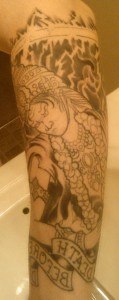
My latest piece depicts the Hindu avatar Kalki. Kalki is the final incantation of Vishnu who comes at the end of humanity’s period of moral abandonment, the Kali Yuga (“age of Kali”) to cleanse the world. He ushers in an age of rebirth called the Satya Yuga (“age of truth”). Kalki is an indifferent judge and smites those who are characteristic of the Kali Yuga so to bring about a purer age.
I originally learned of Hindu cosmology when reading the Upanishads in Ms. Pentola’s high school philosophy class. This, along with the Greco-Roman conception of the Ages of Man, resonates with me as a way of describing the cyclical patterns of human civilization, birth, decline and death. Later when reading what would soon become one of my favorite works of philosophy (Ride the Tiger), Julius Evola argued that the Kali Yuga was already upon us, and that the moral decline of man, perpetuated by the mass willful abandonment of tradition, the sacred and a more naturalistic ordering of civilization was an inevitability. Evola argued that human civilization was moribund and that the virtuous person, in increasingly rare company, might endure the age by carefully doing as the title of the manuscript instructs: skillfully navigating a danger and so exhausting it to it’s end. This imagery and argument is powerfully compelling to me and the figure of Kalki inspirational in his firm reproach of the corruption of the age.
Naturally it follows to get a piece featuring that final form of Vishnu tattooed. My piece is based on a famous painting, with several modifications:
- He is performing the Karana mudra – a Hindu-Buddhist hand gesture for warding off evil. I am aware that traditionally Kalki is illustrated with the Pataka hasta for right and the left hand in Tripataka hasta – but this is my tattoo. If you’re a Hindu scholar and reading this, please pardon my indulgence.
- A scroll readng “Death Before Dishonor” accents the bottom. This to me has to do with practicing virtue under any penalty and the irrelevance of external forces (such as death) in compromising my honor. Honor is not something I would part with. One of my favorite quotes is from Act IV, Scene III of Shakespeare’s Henry V: “But if it be a sin to covet honour, I am the most offending soul alive.”
- Scott Luckas, the artist, took liberties in infusing his unique Tibetan-Japanese style, as well as creating a unique artwork which in my opinion is frankly stunning.
A final point is that there is another force operating during the Kali Yuga: Kali (big surprise there). Kali is a force of destruction and chaos – Kalki one of rejuvenation and purification. I am interested in both opposing what Kali embodies and where possible: helping others, opposing injustice and establishing order. In this sense Kalki is not merely a force for culling evil, but of bringing about a more truthful and harmonious age.
Device and Motto
My left forearm contains arguably the most important tattoo I have: it is a visual representation of my fundamental values. Of my own design, the tattoo depicts an owl clutching a fasces, on a shield. The top of the shield has accents listing the four cardinal virtues, the bottom a scroll with a motto. The left side of the shield has Roman numerals indicating a number.
Symbol: The owl represents wisdom and knowledge. It is also drawn in an ancient, classical form which is representative of Athena, the Hellenistic goddess of wisdom, courage, inspiration, civilization, law and justice, just warfare, mathematics, strength, strategy, the arts, crafts, and skill. Athena is called Minerva by the Romans. The fasces is a bound bundle of wooden rods, sometimes including an axe with its blade emerging. The fasces represents magisterial power and strength through unity. The meaning of this configuration is the proper balance between strength and guiding rationality: wisdom should prevail over and guide power.
Accents: A wrapping scroll displays the four cardinal virtues in Koine Greek: Andreia (Courage/Fortitude), Sophia (Wisdom/Prudence), Dikaiosyne (Justice/Rectitude), Sophrosyne (Temperance). These are the principles of goodness I strive to embody, and the opposites of which I try to avoid; I judge the good of an action on whether or not it is in the service of these characteristics.
Motto:Â The Latin “Virtus Junxit Mors Non Separabit” can be translated a few different ways. My translation is “what virtue has joined, death shall not separate.” This is a saying of the Scottish Rite Free Masons. For the record, I’m not one, although no proper Mason would admit to being one anyway! This speaks to the enduring good we can bring to the world community by developing virtue and acting in the service of others. Death is not the end, or a destroyer of our goodness.
Numerals: 1776. I identify strongly with the neo-classical and republican philosophy of my country’s founding, particularly the writings of Thomas Paine.
Two Civilizations
On my left bicep I have a symbol of the Carthaginian civilization and on the right, that of the Babylonian. This is from a period of my late teens and early twenties when I was obsessed with the study of the Levant and ancient Semitic civilizations/mythology. Carthage represents the furthest west, and Babylon the furthest east. While my study of the ancients eventually settled on the Greco-Roman, my Levantine studies were a gateway to that end, and are still a fond remembrance.
Contra Mundum
These Latin words are on my wrists. From Athanasius of Alexandria, a bishop of Alexandria during the 4th century, it means “against the world” and implies a rejection of general opinion and indecency; otherwise acceptable, endemic vice. Even if Gods do not exist, we must still act nobly given our inherent nature.
Hammer of Justice
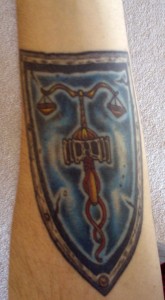
Next to Kalki is a shield displaying a hammer (of justice) with a scale of justice atop it. This is actually from the Forgotten Realms and is the symbol of the god Tyr (not to be confused with the Norse god of the same spelling from historical mythology). I commissioned this tattoo for a few reasons:
- It provides for nerdy D&D types to identify eachother; I used to play a paladin a lot (surprise, surprise!). I once was passing through an airport and a Homeland security guy saw it and gave me a sheepish grin, a chuckle and a thumbs up. Sir, if you’re reading this, email me to roll up a character!
- It reflects how I feel about the relationship between justice and majesty – just as wisdom should provide a framework and inform the application of strength, so should justice temper judgment.
- It’s a friggin war hammer.
Gladiator?
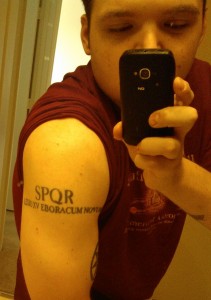
The classical “mark of the legion” – a purported tattoo that Roman legionaries would sport, as made famous in the movie Gladiator. Mine reads “Legion 15: (from) New York.” The significance of 15 is that it is the sacred number of the Babylonian civilization. You might correctly infer that I got this piece during my ancient Semites obsession phase.
Next
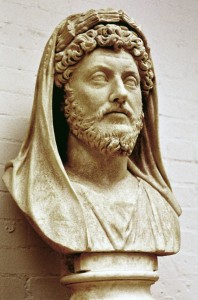
After Kalki is complete (December 13th) i’ll probably be getting a black/grey portrait of Marcus Aurelius, in the habit of the Pontifex Maximus (high priest) on my left arm.
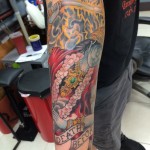
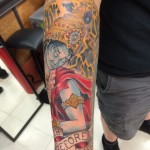
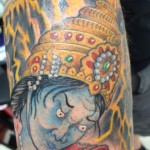
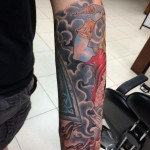
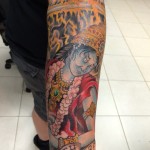
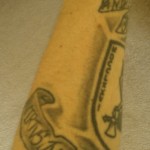
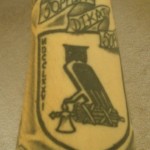
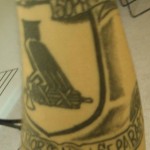
2 replies on “My Tattoos”
New blog post. My tattoos: what they mean. A recurring question I am asked and thus indulge now. http://t.co/Wyyn11ODZU
Cool stuff. I’ve been thinking of getting an Evola-themed tattoo. Or maybe a snarling wolf for the ‘wolf age’ of Nordic tradition, which corresponds to the Indo Kali Yuga and the Hellenistic Iron Age.